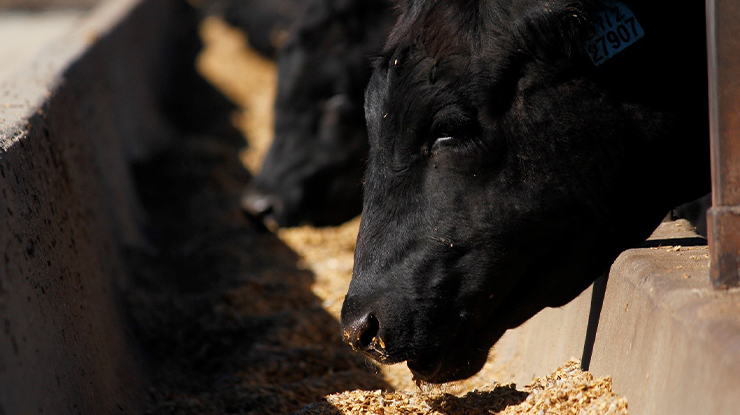
Key points:
- A study of cattle behaviour in Australian feedlots has identified new behavioural distinctions that could help in earlier diagnosis and treatment of Bovine Respiratory Disease (BRD).
- Cattle that ended up becoming sick spent more time at water, at feed bunks, and in a group in the first six days at a feedlot.
- New insights through remote monitoring could improve BRD detection and treatment rates, and animal welfare and productivity outcomes.
- Research findings highlight the importance of understanding the disease progression of BRD, and the time when pen riders are doing observations.
A study of cattle behaviour in Australian feedlots has identified new behavioural distinctions between healthy and sick cattle that could help in earlier diagnosis and treatment of Bovine Respiratory Disease (BRD).
The project saw researchers analyse data collected by remote early disease identification (REDI) technology at a number of Australian feedlots to illustrate specific relationships between individual and group behaviour in cattle and health outcomes.
REDI technology provides objective, 24 hour a day continuous behavioural monitoring and applies classification engines to determine changes in wellness status.
Researchers analysed animal behavioural data, disease occurrences and the magnitude of lung lesions associated with BRD at slaughter.
US veterinarian Professor Brad White, Kansas State University and Precision Animal Solutions, led the project, which was funded by MLA in consultation with the Australian Lot Feeders’ Association (ALFA).
Early behaviour critical
Professor White said the research provides new insights through remote monitoring that could improve BRD detection and treatment rates, and animal welfare and productivity outcomes.
“We found there were some important behavioural distinctions between healthy and sick cattle that carried through to their lung scores at slaughter and then through to carcase performance,” Professor White said.
“The more severe the lung scores were, the lower the carcase performed. This is not surprising, but it becomes important when we talk about associations between animal behaviour and lung consolidation or pleurisy scores at slaughter.
“We found that cattle that ended up being sick spent more time at the feed bunk in the first six days after arrival at a feedlot than healthy cattle.
“Importantly, the cattle spent more time at the bunk in the late evening and early morning hours and less time at the bunk during daylight hours, compared to the healthy cattle,” Professor White said.
Another key finding was the behavioural difference between the sick and healthy cattle at water.
“Again, in the first six days at the feedlot, the sick cattle spent more time at the water. Healthy cattle would spend between 1.5% to 2% of their time at the water, but sick cattle might spend 2.5% of their time or more at the water in those first six days.
“This differed by time of day as well. During the daytime, the water in a feedlot pen is much like the office water cooler – it’s a place where cattle socialise.
“During the day, we often see cattle going up to the water in groups of four, five or six, hang out for a while, then move away.
“However, at night, if they go to the water, they tend to be as singles because they’re thirsty, it’s not a social activity. So we observed sick cattle going up to the water overnight more frequently, likely because they’re dehydrated.”
Behaviour challenges assumptions
At a pen level, the findings were also interesting.
“Sick cattle earlier in the feeding phase had more cattle within three metres of them than healthy cattle, meaning they’re hiding in the group,” Professor White said.
Professor White said the findings challenge some existing assumptions about the behaviour of animals with BRD such as cattle going off by themselves if they’re sick.
“We train pen riders to look for the cattle that are isolated, which is true, but not early in the disease process.
“For most of the BRD we deal with, the main therapy is antimicrobials. Antimicrobials are more effective if given early in the disease process because there are less bacteria for them to battle, and less damage has occurred to the pulmonary tissue and lung tissue.
“We’re starting to develop a picture that illustrates that sick cattle spend more time at water, more time at feed, and more time in a group in the first six days at a feedlot. If you ignore the water aspect, this is almost the opposite of what we tell pen riders to look out for.
“However, after that early phase in the feedlot, sick cattle then get to a certain point where they can no longer compensate for their illness and their behaviour flips to doing things like staying away from the group.”
Professor White said the findings highlighted the importance of understanding the disease progression of BRD, and the time when pen riders are doing observations.
“We think a good time to observe cattle is around feeding time, or just before feeding, which is accurate if you want to observe their feeding behaviour but it’s also a high social pressure time making subtle behavioural changes more difficult to observe,” Professor White said.
“We know BRD is concentrated at the front end of the feeding phase, so if you can observe or monitor them closely during high risk time for BRD, that can make a big difference to health outcomes.”








